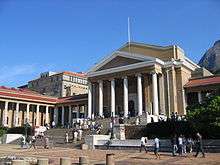SABAP2
SABAP2 is the acronym for the Southern African Bird Atlas Project 2, which is the follow-up to the Southern African Bird Atlas Project (for which the acronym was SABAP, and which is now referred to as SABAP1). The first atlas project took place from 1987–1991. The current project is a joint venture between the Animal Demography Unit at the University of Cape Town, BirdLife South Africa and the South African National Biodiversity Institute (SANBI). The project aims to map the distribution and relative abundance of birds in southern Africa, and the original atlas area included South Africa, Lesotho, and Swaziland, although since 2012 the project has expanded to include Namibia, Botswana, Zimbabwe and Mozambique. SABAP2 was launched on 1 July 2007, and it has been planned to run indefinitely.
The field work for this project is conducted by more than 1700 volunteers, known as citizen scientists – they collect the data in the field at their own cost and in their own time. As such they make a huge contribution to the conservation of birds and their habitat. In SABAP1, bird lists were collected for quarter degree grid cells, which are 15 minutes by 15 minutes, or approximately 27 km by 25 km in size. In SABAP2, the resolution is far higher: the unit of data collection is the pentad – five minutes of latitude by five minutes of longitude – i.e. squares with sides of roughly 9 km, one ninth the size of quarter degree grid cells. There are 17 000 pentads in the original atlas area of South Africa, Lesotho and Swaziland, and a further 10 000 in Namibia.
By June 2015, the SABAP2 database contained more than 128 000 checklists, and a total of 7.4 million records of bird distribution in the project database. In June 2015, the number of SABAP2 records exceeded that of SABAP1 for the first time. More than 72% of the original SABAP2 atlas area (i.e. South Africa, Lesotho and Swaziland) had at least one checklist by that time. This information is updated continuously on the project website; see External links below.
A number of postgraduate research projects have been based partially or completely on SABAP data, either from SABAP1 only, SABAP2 only, or comparing the changes in bird distributions and reporting rates from SABAP1 to SABAP2. Many scientific research articles have also been published on these and other analyses. See External links for some examples of postgraduate dissertations and published articles that make use of SABAP data.
See also
References
External links
- SABAP2-website]
- BirdLife South Africa
- SANBI
- Slideshow demonstrating range changes of seven species between SABAP1 and SABAP2
- SABAP2 report: 6 December 2012, published in Ornithological Observations
- MSc dissertation, University of Cape Town. Megan Loftie-Eaton (2014) Geographic Range Dynamics of South Africa's Bird Species
- Slideshow: Secretarybirds and citizen science in South Africa
- PhD thesis, University of Cape Town. Sally Hofmeyr (2012)
- MSc dissertation, University of Cape Town. Dale Wright (2011)
- Preliminary summary of changes in bird distributions between the First and Second Southern African Bird Atlas Projects (SABAP1 and SABAP2). Paper published in Ornithological Observations
| |||||||||||||||||||||||||||||||||||||
